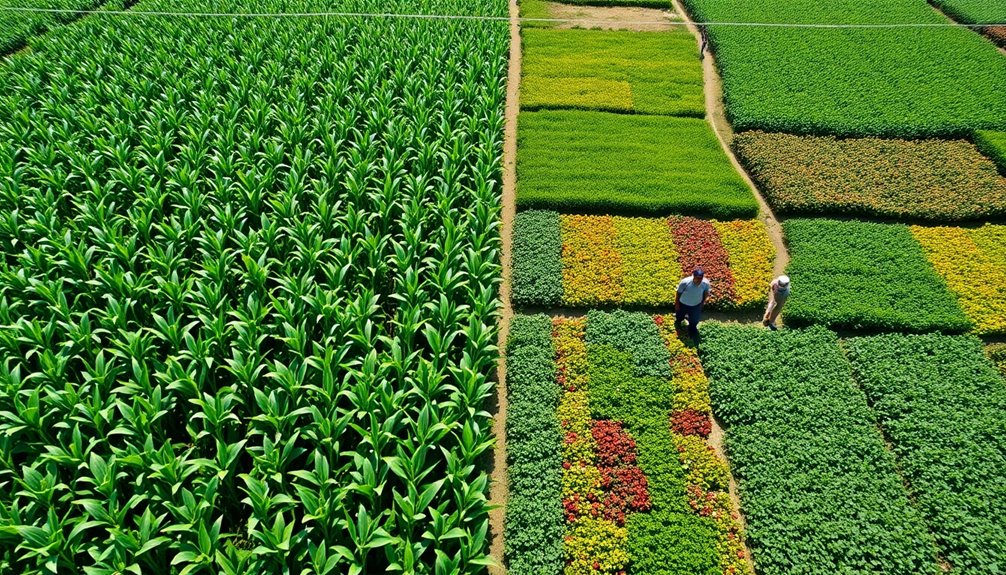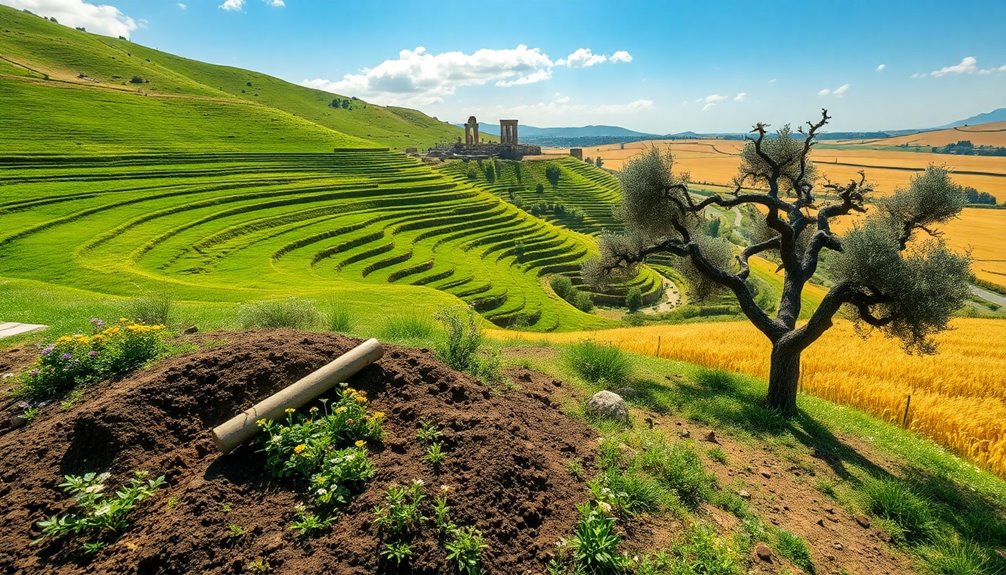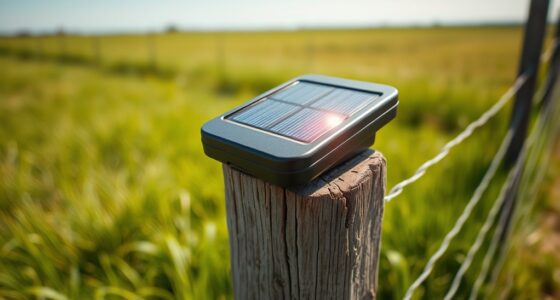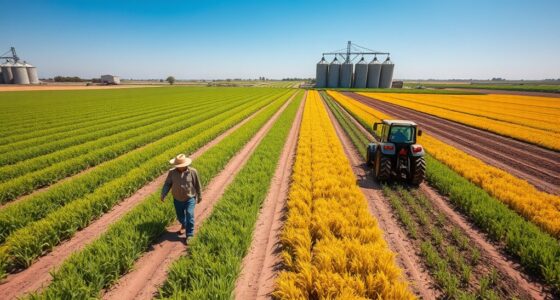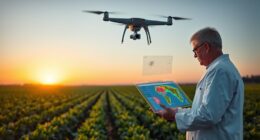Intensive farming is all about maximizing agricultural yields by using high-density practices. You'll see crops and livestock raised in confined spaces to achieve considerably higher outputs—up to three times more per acre compared to traditional methods. This approach relies heavily on mechanization, chemical fertilizers, and precision agriculture to boost efficiency. While it helps meet global food demands, it can lead to environmental issues like soil degradation and water scarcity. By understanding both its advantages and disadvantages, you can better appreciate the complexities of this farming method and how it shapes modern agriculture.
Key Takeaways
- Intensive farming maximizes agricultural output through high-density practices and high input usage, including fertilizers and pesticides.
- It employs mechanization and advanced irrigation techniques to enhance efficiency and yields.
- Types include intensive crop farming, livestock farming, greenhouse farming, and hydroponics.
- This farming method achieves 2-3 times higher yields per acre compared to traditional practices.
- While it increases food production, it raises concerns about environmental degradation and animal welfare.
Definition of Intensive Farming
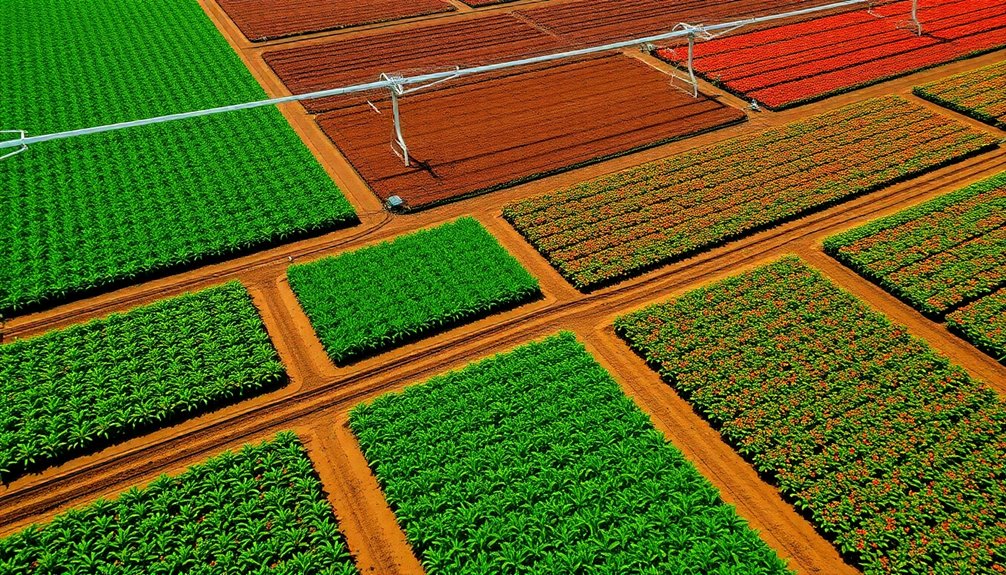
Intensive farming, often seen as a response to growing food demands, is a method of agriculture that focuses on maximizing production through the use of high levels of inputs like fertilizers, pesticides, and water.
This approach notably enhances crop yields and agricultural productivity by employing advanced technologies such as mechanization and irrigation systems.
You'll find that intensive farming often relies on high-density planting and monoculture practices, where a single crop variety dominates the landscape.
Additionally, the use of genetically modified organisms (GMOs) plays an essential role in boosting output.
Emerging during the Green Revolution, this method also applies to livestock production via concentrated animal feeding operations (CAFOs), where large numbers of animals are raised in confined spaces to optimize meat, milk, and egg production.
Key Features of Intensive Farming
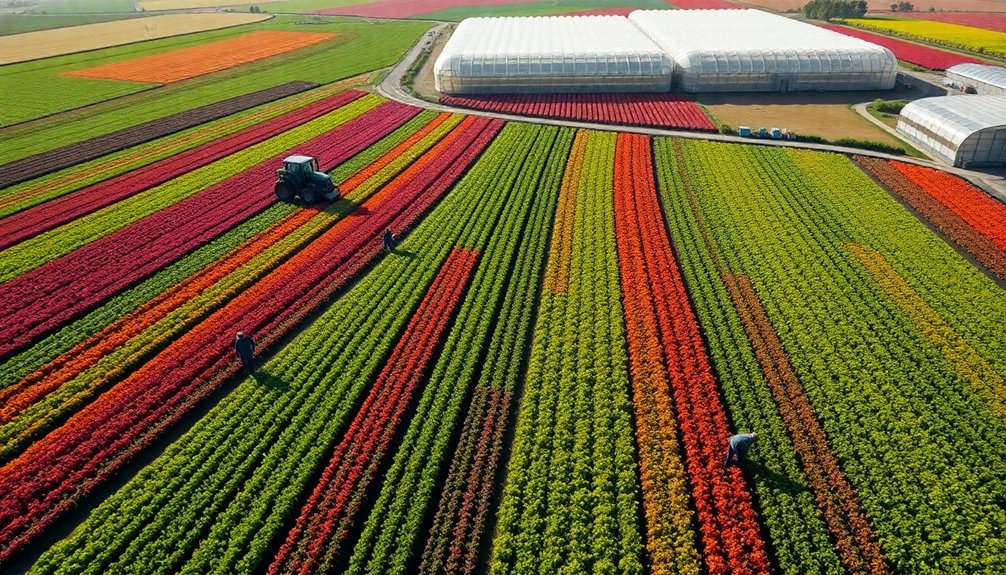
In intensive farming, you'll notice a heavy reliance on high input usage, including fertilizers and pesticides, which boosts crop yields considerably.
You also see mechanized operations at play, with advanced machinery making planting and harvesting much more efficient.
These features together create a system designed for maximum productivity on limited land.
High Input Usage
High input usage is a defining feature of modern farming techniques, showcasing how farmers leverage various resources to boost productivity.
By employing chemical fertilizers and pesticides, you can enhance crop health and maximize yields per unit of land. Advanced irrigation methods, like drip and sprinkler systems, guarantee efficient water use, especially in areas with limited resources.
Monoculture practices allow for the extensive cultivation of a single crop variety, increasing efficiency but raising concerns about soil health and pest vulnerability.
In livestock farming, high-density practices enable you to raise large numbers of animals in confined spaces, greatly increasing meat, milk, and egg production.
However, these methods often come with ethical and environmental trade-offs that must be considered.
Mechanized Operations
Mechanized operations are revolutionizing modern agriculture, making farming more efficient than ever. With advanced machinery like tractors, harvesters, and seed drills, you can plant, cultivate, and harvest crops faster, considerably cutting down on labor time and costs.
The precision application of fertilizers and pesticides guarantees peak crop health while reducing waste and environmental impact. For high-density livestock farming, automated feeding and cleaning systems enhance productivity and lower reliance on manual labor.
In greenhouse settings, mechanized systems regulate climate conditions for year-round crop production, maximizing yield. By integrating technology such as GPS-guided tractors, you improve resource management and contribute to sustainable farming practices, making your operations not only more efficient but also environmentally responsible.
Types of Intensive Farming
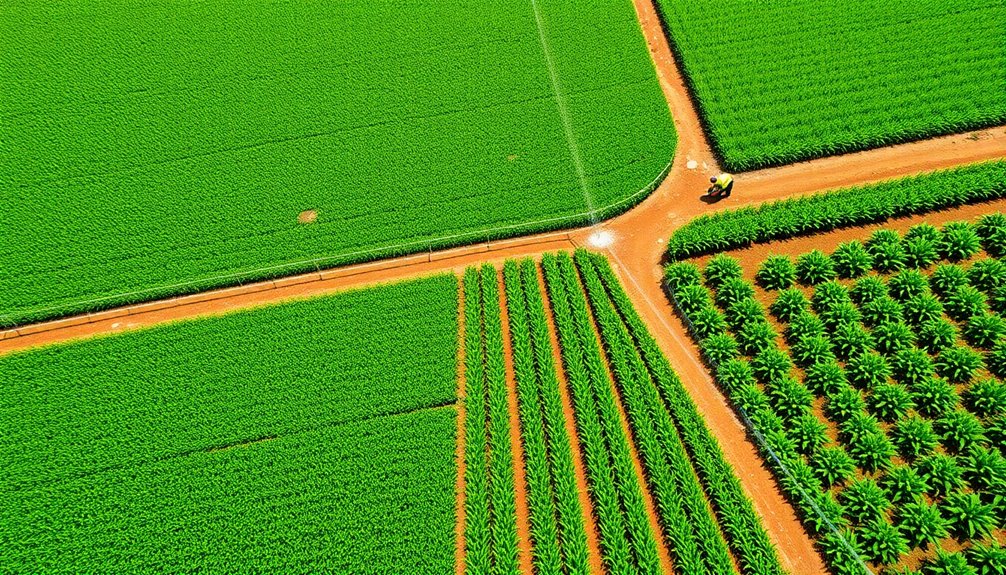
Intensive farming encompasses various practices designed to maximize agricultural output and efficiency.
You can explore different types of intensive farming, such as intensive crop farming, which relies on high input levels of fertilizers, pesticides, and water, often incorporating genetically modified organisms (GMOs) for better yields.
In livestock farming, large numbers of animals are raised in confined spaces, optimizing feed efficiency and increasing production of meat, milk, and eggs.
Greenhouse farming utilizes advanced technology to create controlled environments for year-round crop growth.
Hydroponics and aquaponics are innovative soil-less systems that maximize space and resources, allowing crops and fish to thrive together.
Feedlot farming focuses on feeding animals high-energy diets in confined areas to accelerate growth and prepare them for market efficiently.
Techniques Used in Intensive Farming
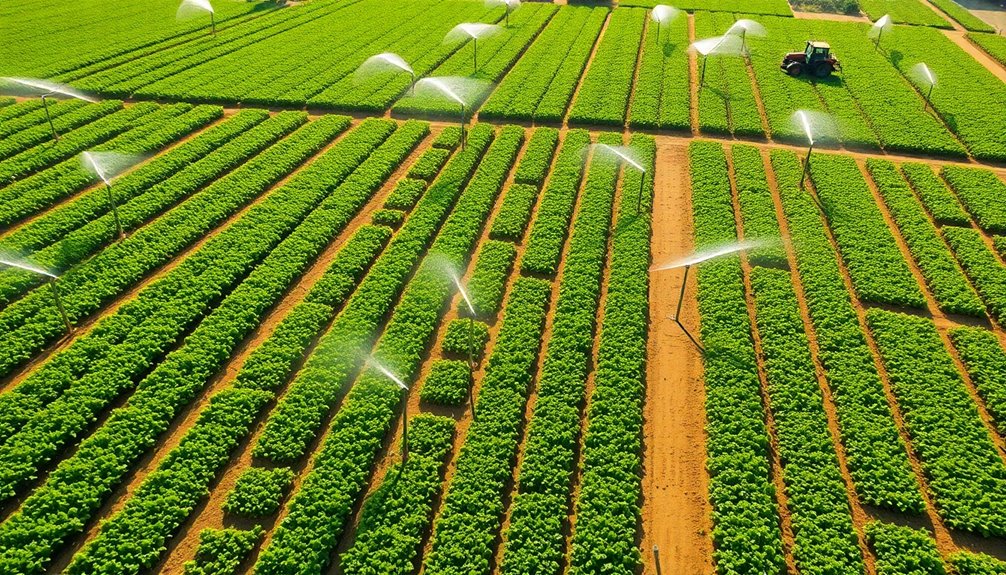
In intensive farming, you'll use advanced irrigation methods like drip and sprinkler systems to maximize water efficiency.
You'll also optimize chemical inputs to boost crop yields while managing pests effectively.
Plus, embracing mechanization and technology will streamline your farming operations, making everything more efficient.
Advanced Irrigation Methods
Advanced irrigation methods play an essential role in enhancing agricultural efficiency and sustainability. By using advanced irrigation techniques like drip and sprinkler systems, you can achieve remarkable water efficiency, cutting evaporation and runoff losses by up to 50%. Precision irrigation technologies, including soil moisture sensors and automated irrigation controllers, enable you to apply water only when necessary, boosting crop productivity and conserving resources. Additionally, hydroponics and aquaponics utilize controlled water environments, delivering yield improvements of up to 90% less water than conventional farming. Integrating sustainable irrigation practices, such as rainwater harvesting, guarantees a reliable water supply while minimizing environmental impact.
| Method | Water Efficiency | Yield Improvement |
|---|---|---|
| Drip Irrigation | Up to 50% | 20-40% |
| Sprinkler Systems | Up to 50% | 20-40% |
| Hydroponics | Up to 90% | High |
| Aquaponics | Up to 90% | High |
| Automated Systems | Optimized | High |
Chemical Inputs Optimization
Optimizing chemical inputs is key for maximizing productivity in modern farming practices. By focusing on effective use of these inputs, you can greatly enhance your yields.
Here are three optimization techniques to evaluate:
- Chemical Fertilizers: Apply nitrogen-based fertilizers correctly to boost crop yields by 50-100%.
- Pesticides and Herbicides: Use these to protect crops and control weeds, potentially increasing yields by up to 30% in monoculture systems.
- Genetically Modified Organisms (GMOs): Incorporate GMOs to improve pest resistance, leading to an average yield increase of 22% for crops like corn and soybeans.
Additionally, advanced irrigation methods can optimize water consumption, ensuring you maintain high yields while conserving resources.
Mechanization and Technology Use
How can modern technology transform your farming practices? By embracing mechanization, you can streamline planting and harvesting with advanced tools like tractors and harvesters, boosting your efficiency and productivity.
Precision agriculture techniques, such as drones and GPS, enable you to monitor crop health and optimize resource use, reducing waste and enhancing performance.
In high-density farming, automated irrigation systems, like drip and sprinkler setups, guarantee every drop of water is used effectively.
Furthermore, using genetically modified organisms (GMOs) allows you to cultivate resilient crops, leading to higher yields.
For livestock farming, feeding technologies optimize feed delivery, maximizing meat, milk, and egg production in confined spaces. Additionally, integrating hydrogen fuel cells into agricultural machinery can provide a cleaner energy source, reducing emissions and enhancing sustainability.
Advantages of Intensive Farming
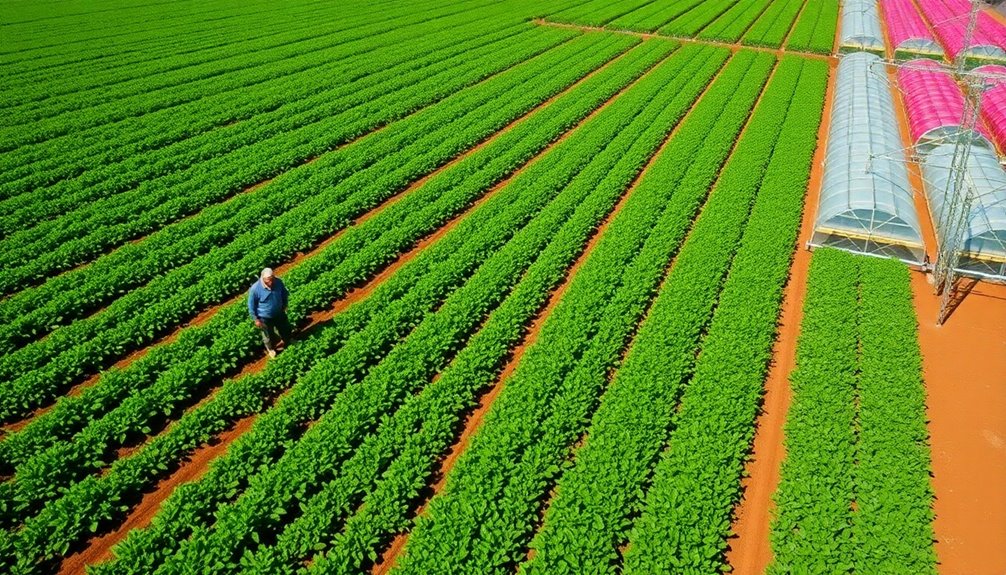
Intensive farming offers several key advantages that can greatly boost food production. By implementing advanced agricultural techniques, you can achieve high yields—often 2-3 times more per acre than traditional methods.
Here are some benefits:
- Year-round crop cultivation: This reduces reliance on seasonal weather patterns, ensuring a consistent food supply.
- Resource optimization: Mechanization and chemical fertilizers enhance production efficiency, leading to higher economic returns.
- High-density livestock farming: This allows for larger quantities of meat, milk, and eggs in confined spaces, maximizing land and feed use.
With precision agriculture technologies, you can target inputs, reduce waste, and improve produce quality, all while minimizing environmental impact.
These advantages make intensive farming a crucial practice in meeting global food demands.
Disadvantages of Intensive Farming
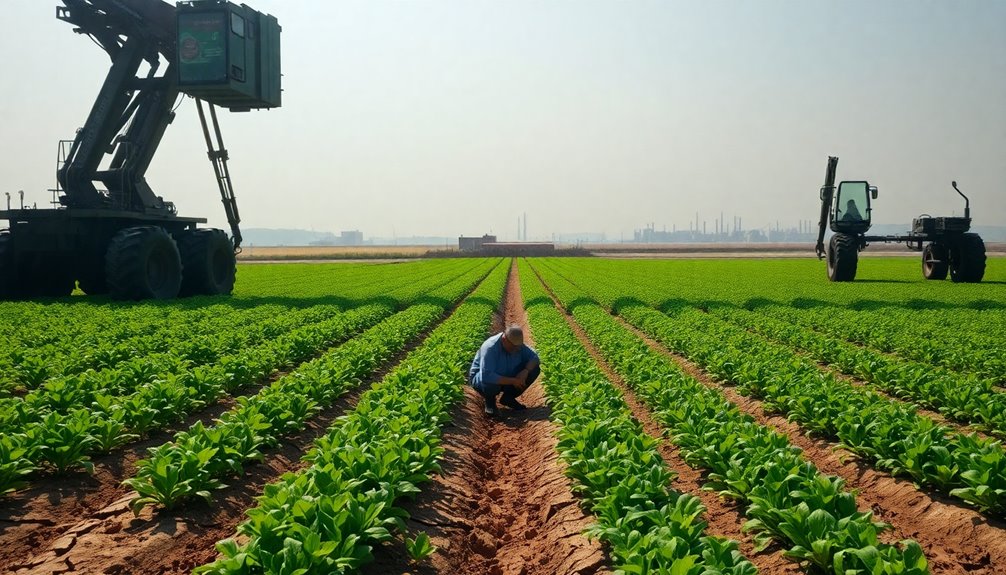
While intensive farming can boost production, it also brings significant disadvantages that shouldn't be overlooked.
One major issue is environmental degradation, as chemical fertilizers and pesticides often contaminate soil and water resources, disrupting ecosystems. The reliance on monoculture reduces biodiversity, making crops more vulnerable to pests and diseases, which leads to increased pesticide use and potential crop failures.
High-density livestock farming raises serious animal welfare concerns, confining animals to limited spaces, causing stress and health problems.
Additionally, overexploitation of water resources for irrigation can deplete local aquifers, worsening regional water scarcity.
Continuous cultivation without fallow periods results in soil degradation, compromising the long-term productivity of agricultural land and threatening sustainable farming practices.
Technological Innovations in Intensive Farming
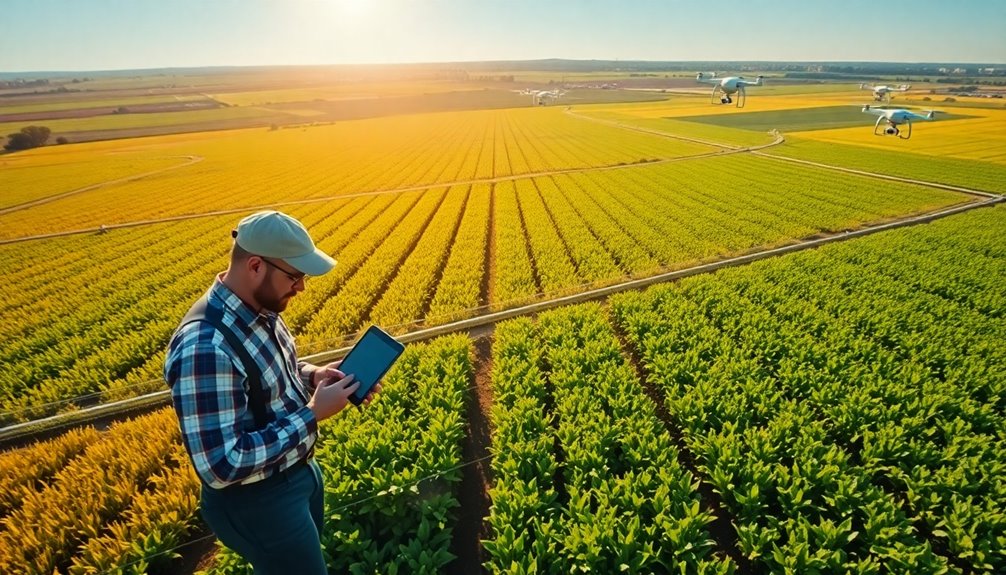
Embracing technological innovations in intensive farming is transforming agricultural practices and enhancing productivity. By adopting these advancements, you can optimize resources and improve crop management.
Here are three key innovations to contemplate:
- Precision Farming: Tools like drones and GPS-guided tractors help you monitor crop health and manage resources efficiently.
- Hydroponics and Aquaponics: These soil-less farming methods maximize space and enable year-round production of high-value crops.
- Artificial Intelligence: AI-driven analytics provide insights into crop health and resource consumption, facilitating timely interventions.
Additionally, advanced irrigation systems considerably reduce water usage, while genetically modified organisms (GMOs) enhance crop resilience and yields. Furthermore, the implementation of solar-powered irrigation systems can significantly enhance crop yields and efficiency in intensive farming practices.
Environmental Impacts of Intensive Farming
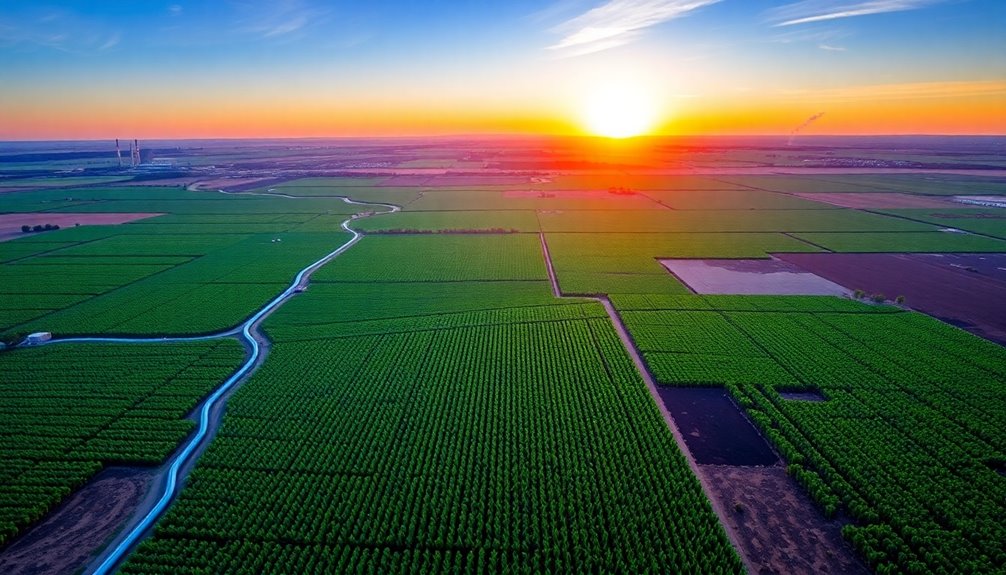
The advancements in technology that enhance productivity in farming come with significant environmental consequences. Intensive farming practices lead to serious environmental impacts like soil degradation and water pollution. The reliance on chemical fertilizers contributes to soil compaction and erosion, while runoff carries harmful substances into water bodies, affecting ecosystems and human health. Monoculture reduces biodiversity, making crops more vulnerable to pests, and concentrated animal feeding operations (CAFOs) generate immense greenhouse gas emissions. Overusing irrigation further depletes local water resources, creating competition in drought-prone areas.
| Environmental Impact | Effect |
|---|---|
| Soil Degradation | Compaction and erosion |
| Water Pollution | Contaminated aquatic ecosystems |
| Greenhouse Gas Emissions | Methane from livestock |
Sustainable Alternatives to Intensive Farming
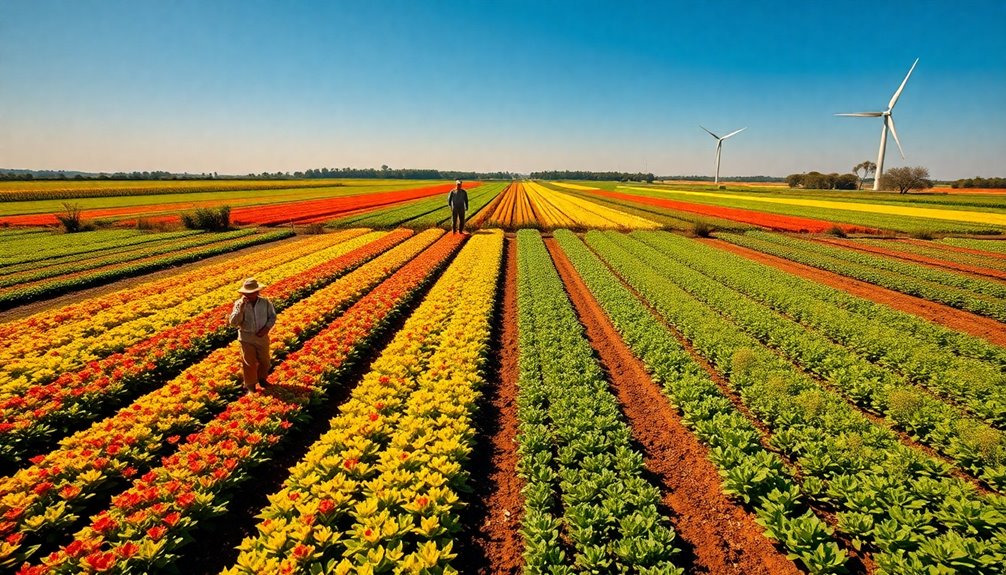
Sustainable alternatives to intensive farming offer viable solutions to the pressing environmental issues caused by conventional methods.
By adopting these practices, you can contribute to a healthier ecosystem and better food systems.
Here are three key sustainable practices to evaluate:
- Organic Farming: This method relies on natural inputs, enhancing soil health and biodiversity while minimizing chemical inputs.
- Permaculture: By designing systems that mimic natural ecosystems, permaculture promotes resilience and efficient resource use.
- Vertical Farming: This innovative approach utilizes controlled environments to grow crops in stacked layers, reducing the need for chemical inputs and transportation emissions.
Incorporating agroecology and regenerative agriculture principles can further restore soil health and improve biodiversity, leading to a sustainable future for agriculture.
Frequently Asked Questions
What Are Intensive Farming Practices?
Intensive farming practices involve maximizing crop and livestock yields through various methods. You might use chemical fertilizers and pesticides to boost production and rely on monoculture to grow a single crop type efficiently.
Advanced irrigation systems like drip and sprinkler help optimize water use. With high-density livestock farming, you can raise many animals in confined spaces.
Techniques like hydroponics and aquaponics allow you to cultivate crops in soil-less environments, increasing efficiency further.
What Is the Meaning of Intensive Farming?
Did you know that over 75% of the world's food supply comes from just 12 crops?
Intensive farming refers to an agricultural approach where you maximize crop and livestock yields by using high levels of inputs like fertilizers and technology. This method aims to increase food production efficiently, often on smaller land plots.
While it boosts productivity, it can also lead to environmental concerns and ethical issues regarding animal welfare.
What Are Intensive Farming's Advantages and Disadvantages?
When you consider intensive farming, you'll find both advantages and disadvantages.
On one hand, it boosts food production and maximizes land use, which can be economically beneficial for farmers.
However, it also leads to significant environmental issues, like soil erosion and water pollution.
You might also be concerned about animal welfare, as livestock are often kept in cramped conditions.
Balancing these factors is essential for sustainable agricultural practices moving forward.
What Is an Example of an Intensive System?
One example of an intensive system is Concentrated Animal Feeding Operations (CAFOs). In CAFOs, you raise a large number of livestock in confined spaces to boost feed efficiency and meat production.
This approach allows you to maximize output while minimizing land use.
Hydroponics is another example, where you grow crops in nutrient-rich water, enabling year-round production.
These methods illustrate how intensive farming can greatly increase agricultural efficiency and productivity.
Conclusion
To sum up, intensive farming can be a double-edged sword. While it promises higher yields and efficiency, you must weigh the benefits against the environmental costs. By embracing sustainable alternatives, you can cultivate a healthier balance between productivity and preservation. Remember, the path to a sustainable future doesn't have to be a barren field; it can be a lush garden where both nature and agriculture thrive in harmony. Your choices today shape the world of tomorrow.

